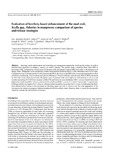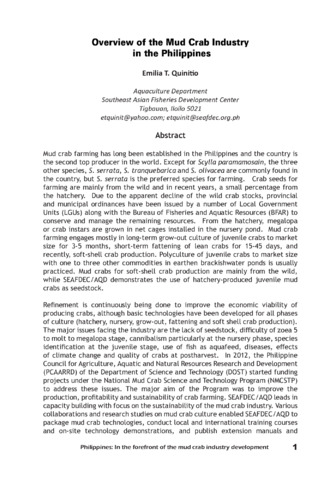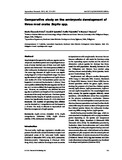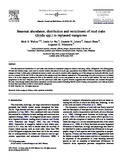Evaluation of hatchery-based enhancement of the mud crab, Scylla spp., fisheries in mangroves: comparison of species and release strategies

View/
Request this document
Date
2009Author
Page views
201Metadata
Show full item recordCited times in Scopus
Share
Abstract
Ranching, stock enhancement and restocking are management approaches involving the release of wild or hatchery-bred organisms to enhance, conserve or restore fisheries. The present study, conducted from April 2002 to November 2005, evaluated the effectiveness of releasing wild and hatchery-reared (HR) mud crabs in the mangroves of Ibajay, Aklan, Philippines where preliminary studies demonstrated declining fishery yields, abundance and size of crabs. Comparison of survival and growth of wild-released and HR Scylla olivacea and HR Scylla serrata demonstrated the effect of nursery conditioning, size-at-release and species differences. Overall yield and catch per unit effort (CPUE) increased by 46% after stock enhancement trials. Recapture rates of released crabs were highest in wild-released S. olivacea and in crabs measuring 65.0–69.9 mm carapace width (CW) and lowest in non-conditioned HR S. serrata. Growth rates were highest for conditioned HR S. olivacea and lowest for conditioned HR S. serrata (11.7 and 3.7 mm month-1 respectively). Fishing mortality was highest for S. olivacea, whereas natural mortality was greater for S. serrata. Conditioning hatchery-bred animals before release is also important in obtaining higher survival. S. olivacea was the more appropriate of the two species for release in mangrove habitats inundated with low-salinity water. However, there is a need for site-specific studies to evaluate the effectiveness of releases.
Suggested Citation
Lebata, M. J. H. L., Le Vay, L., Walton, M. E., Biñas, J. B., Quinitio, E. T., Rodriguez, E. M., & Primavera, J. (2009). Evaluation of hatchery-based enhancement of the mud crab, Scylla spp., fisheries in mangroves: comparison of species and release strategies. Marine and Freshwater Research , 60(1), 58-69. https://doi.org/10.1071/MF08155
DOI
10.1071/MF08155Subject
hatcheries; growth rate  ; stocking (organisms)
; stocking (organisms)  ; crab fisheries
; crab fisheries  ; nursery grounds
; nursery grounds  ; depleted stocks
; depleted stocks  ; marine crustaceans
; marine crustaceans  ; mangroves
; mangroves  ; fishing
; fishing  ; mortality
; mortality  ; abundance
; abundance  ; fisheries
; fisheries  ; survival
; survival  ; habitats
; habitats  ; ranching; mud
; ranching; mud  ; Decapoda
; Decapoda  ; Scylla
; Scylla  ; Scylla serrata
; Scylla serrata  ; Scylla olivacea
; Scylla olivacea 
 ; stocking (organisms)
; stocking (organisms)  ; crab fisheries
; crab fisheries  ; nursery grounds
; nursery grounds  ; depleted stocks
; depleted stocks  ; marine crustaceans
; marine crustaceans  ; mangroves
; mangroves  ; fishing
; fishing  ; mortality
; mortality  ; abundance
; abundance  ; fisheries
; fisheries  ; survival
; survival  ; habitats
; habitats  ; ranching; mud
; ranching; mud  ; Decapoda
; Decapoda  ; Scylla
; Scylla  ; Scylla serrata
; Scylla serrata  ; Scylla olivacea
; Scylla olivacea 
Taxonomic term
Collections
- AQD Journal Articles [1222]
Related items
Showing items related by title, author, creator and subject.
-
Overview of the mud crab industry in the Philippines
Quinitio, Emilia T. (Aquaculture Department, Southeast Asian Fisheries Development Center, 2017)Mud crab farming has long been established in the Philippines and the country is the second top producer in the world. Except for Scylla paramamosain, the three other species, S. serrata, S. tranquebarica and S. olivacea ... -
Comparative study on the embryonic development of three mud crabs Scylla spp.
Ates, Maria Charmela D.; Quinitio, Gerald F.; Quinitio, Emilia T.; Sanares, Roman C. (Blackwell Publishing, 2012)Morphological changes in the embryos, egg size and development, incubation period and morphological structures of newly hatched zoea of three mud crab Scylla species were determined. The three species exhibited similar ... -
Seasonal abundance, distribution and recruitment of mud crabs (Scylla spp.) in replanted mangroves
Walton, Mark E.; Le Vay, Lewis; Lebata, Junemie H.; Binas, Joseph; Primavera, Jurgenne (Elsevier, 2006)The abundance and distribution of mud crabs were studied in a replanted mangrove forest in Buswang, Aklan, Philippines. Two fishing gears, lift nets and bamboo traps, were used to monitor relative abundance of Scylla spp. ...




